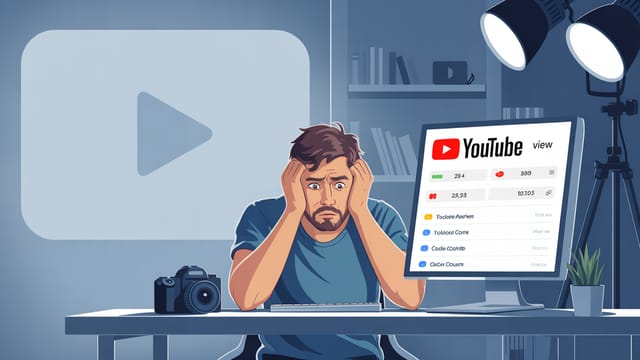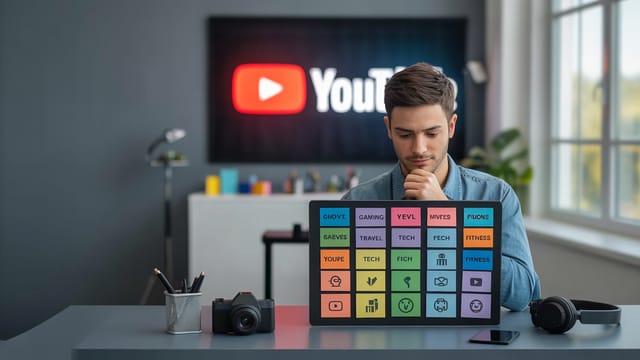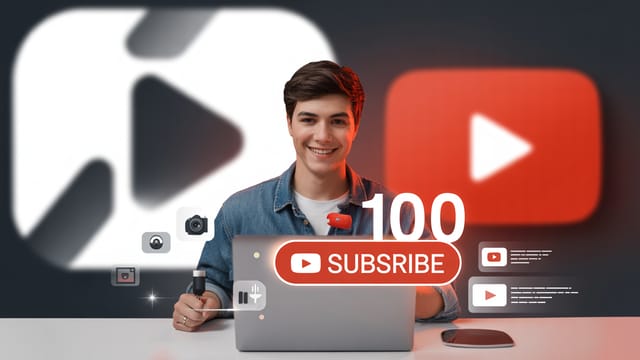
Ready to get your next 10,000 subscribers?
Join thousands of creators who use Subscribr to create faster, better YouTube videos.
How to Use Google Search to Outline & Deepen Your YouTube Content
Are you a YouTube creator who struggles to consistently come up with fresh, engaging video ideas? Do you feel uncertain about whether your video topics will actually resonate with viewers? You're not alone. Many creators hit walls when trying to brainstorm, relying solely on YouTube's search bar or their own ideas.
But what if you could tap into a massive source of audience questions and popular topics that goes beyond the YouTube platform itself? You can, by using Google Search.
While YouTube is its own ecosystem, Google Search provides incredible insights into what people are actively searching for right now. By strategically leveraging Google's search results, you can not only discover new video ideas but also build more comprehensive and valuable outlines for your existing topics. This approach helps you address specific audience pain points and ensures your content has the depth people are looking for.
Let's dive into how Google Search can become one of your most powerful tools for YouTube content planning.
Why Google Search is a Goldmine for YouTube Creators
You might think Google Search is just for finding websites, but it's also a reflection of the collective curiosities, problems, and interests of billions of users. Since Google owns YouTube, there's often a strong connection between what ranks well in Google's text search results and what people are interested in watching videos about.
Using Google Search helps you:
- Validate Ideas: See if there's existing interest in your topic outside of the YouTube bubble.
- Discover Specific Questions: Uncover the exact questions people are asking related to your topic.
- Find Different Angles: Get inspired by perspectives or sub-topics you might not have considered.
- Structure Your Content: Use well-structured articles as a blueprint for your video outline.
- Drive External Traffic: Create content that has a chance of ranking in Google Search results, bringing new viewers to your channel.
This strategic research is a key part of a robust content creation workflow. Tools like Subscribr integrate research capabilities to streamline this process, allowing you to bring insights directly into your script planning.
Unlocking Video Ideas with Basic Google Searches
Start with a simple search related to your niche or a broad topic you're considering. As you type into the Google search bar, pay attention to the autocomplete suggestions. Just like on YouTube, these suggestions reflect popular search queries. Sometimes, the Google suggestions will offer slightly different phrasing or related concepts than YouTube, giving you alternative angles.
For instance, if your niche is "beginner photography," typing that into Google might show suggestions like "beginner photography tips," "beginner photography gear," or "beginner photography composition." These basic suggestions are a great starting point for potential video topics.
Deepening Your Outline with "People Also Ask"
One of the most valuable features for YouTube creators in Google Search results is the "People also ask" box. This box typically appears near the top of the search results and lists common questions that users ask related to your initial query.
Each question in the "People also ask" section is a potential video idea or, even better, a section within a larger video.
Let's say you search for "how to start gardening." The "People also ask" box might include questions like:
- What are the easiest vegetables to grow for beginners?
- What month should I start a garden?
- How do I prepare soil for a new garden bed?
- What are the essential tools for beginning gardeners?
These questions are gold! They tell you exactly what related information people are looking for. You can use these questions to:
- Generate new video ideas: Turn each question into its own dedicated video.
- Build a comprehensive outline: Structure a single, in-depth video by using these questions as main points or subheadings. For example, a video titled "Gardening for Beginners" could have sections addressing soil preparation, easy vegetables, essential tools, and timing.
By answering these specific, commonly asked questions within your video, you make your content more valuable and directly address audience needs. Subscribr's Research Assistant can help you gather and organize these types of insights alongside other research materials, making it easy to integrate them into your script outline.
Leveraging Top-Ranking Articles for Structure and Detail
When you search for a topic on Google, analyze the top-ranking articles. Google ranks these pages because they provide comprehensive, valuable information that satisfies user intent. Often, these articles are structured logically with clear headings and subheadings.
You can use the structure of these successful articles as a blueprint for your video outline. Look at the table of contents or the main headings (H2s and H3s) within the article.
For example, if you're planning a video about "affiliate marketing for beginners" and a top-ranking article has sections like:
- What is Affiliate Marketing?
- How Does Affiliate Marketing Work?
- Finding Your Niche
- Choosing Affiliate Programs
- Building Your Platform (Website/YouTube Channel)
- Creating Content That Converts
- Tracking Your Results
You can adapt this structure for your video outline. Your video could cover each of these points as distinct segments. This saves you time in figuring out a logical flow and ensures you cover the key aspects of the topic that Google has identified as important based on search behavior. Remember to add your own unique insights, examples, and personality to make the content your own.
This process aligns perfectly with the Frame Development phase in Subscribr's script building pipeline, where you define your content angle and build out your outline based on solid research.
Finding Unique Angles and Specific Tips
Beyond the main structure, delve deeper into the content of top articles. Look for specific tips, examples, or perspectives that stand out. Sometimes, searching for "[your topic] tips" can reveal listicles or guides that offer actionable advice. Google often highlights these tips directly in the search results summary.
Reading through a few different top articles can also help you identify unique angles. Maybe one article focuses heavily on a specific tool, or another highlights a less common strategy. These could inspire a video idea focused on that specific angle, helping you stand out from creators covering the topic more generally.
Even results from forums like Reddit that sometimes appear in Google Search can offer real-world questions and perspectives that lead to unique video ideas or specific points to address in your script.
Turning Listicles into Video Concepts
Many top-ranking articles on Google are "listicles" (e.g., "10 Ways to Improve Your Sleep," "5 Best Budget Cameras"). These are perfect candidates for conversion into YouTube videos. A blog post titled "8 Proactive Classroom Management Tips" can easily become a video titled "5 Classroom Management Tips That Actually Work."
By transforming these proven, well-structured text formats into engaging video content, you leverage a format that Google already recognizes as valuable and easy to digest. This can potentially help your video rank not only on YouTube but also on the first page of Google search results, driving significant external traffic to your channel.
Integrating Google Insights into Your Workflow
Effectively using Google Search for YouTube content requires a systematic approach.
- Start with a broad topic or initial idea.
- Perform a Google Search: Use your topic as the query.
- Analyze Autocomplete: Note down any interesting variations or related concepts.
- Explore "People Also Ask": Copy down all the questions in this section. These are your potential video segments or standalone ideas.
- Review Top Articles: Open a few high-ranking articles. Look at their structure (headings) and note key points or unique tips.
- Synthesize Your Findings: Combine the insights from autocomplete, "People Also Ask," and the top articles.
- Build Your Outline: Use the collected questions and article structures to create a logical outline for your video script. Ensure your outline directly addresses the questions found in "People Also Ask."
- Write Your Script: Flesh out your outline into a full script, incorporating the detailed tips, examples, and unique angles you discovered.
Platforms like Subscribr are designed to streamline this entire process. You can use Subscribr's integrated research tools to pull in information from the web, organize your findings, and directly build your script outline and draft within the platform. This helps you stay organized and ensures your research directly informs your content creation.
Conclusion
Don't underestimate the power of Google Search in your YouTube content strategy. By looking beyond the YouTube platform and strategically analyzing Google's search results, particularly the "People also ask" feature and the structure of top-ranking articles, you can unlock a wealth of video ideas and create more comprehensive, valuable content.
This method directly addresses the pain points of struggling for ideas and uncertainty in keyword research by showing you what questions real people are asking. Incorporating this into your workflow, perhaps with the help of tools like Subscribr, allows you to build goodwill with your audience by providing content that truly meets their needs, ultimately contributing to your channel's growth and success. Start using Google Search today to deepen your content and connect with a wider audience.





